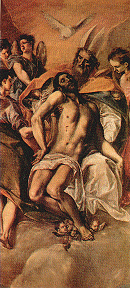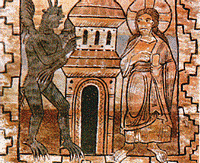Ancient philosophers were enthralled by the mathematical relationships they found in nature, and believed that numbers underlay every aspect of reality. HILDI HAWKINS explains how certain numbers then acquired their own symbolic 'personality'
THE MOST FUNDAMENTAL arithmetical operation is tallying: the
matching one for one of one set of objects with another or with marks in
the dust, or pebbles, or
knots in a string in order to compare quantities.
The next step is to give names to numbers and to match objects against these
in sequence - that is, to count. Some peoples, such as certain New Guineans
and Brazilian Indians, have no names for numbers beyond three. And the number
words that do exist may vary according to the type of object being counted.
(This survives in modern English: we speak of a brace of gamebirds, pistols
or dogs, but of nothing else.) It must have been a magical moment when the
abstract nature of number was realised: the idea that three trees, three
people, or even a collection of three different things all had one thing
in common: their 'threeness'.
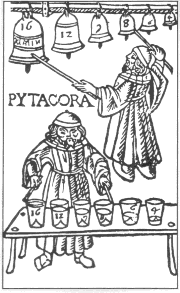 |
| Pythagoras and a disciple experiment with musical tones. The size of a bell or the amount of water in a cup determines the pitch of the note each produces. The discovery by Pythagoras that simple numerical ratios between these quantities correspond to harmony or discord between notes fed his belief that 'all is number' |
The power of this abstract idea must have been apparent very
early. Number seemed somehow to underlie reality: all collections of three
objects were united by their 'threeness'. At a very deep level, perhaps they
were the same. It is small wonder that the mysterious power of the concept
of number inspired a powerful tradition of mystical thought that still colours
the way we think about numbers. The tradition comes to us from the medieval
Christian Church, which in turn drew its inspiration from two major intellectual
traditions, Greek Pythagoreanism and
Hebrew
gematria.
The school of Pythagoras was a religious community
founded by the semi-legendary figure of Pythagoras
in the Greek colony of Croton, in southern Italy, around 530 BC. It was
dedicated to the study of geometry, mathematics and
astronomy, and to experimentation in music.
The Pythagorean school studied the variations in pitch produced by vibrating
strings of varying lengths, and is credited with the discovery that musical
intervals may be represented in terms of simple ratios of whole numbers.
It may have been the discovery of
the mathematical
nature of musical intervals that gave the Pythagoreans their idea that
number was the key to the Universe. Whatever the
origin of the belief, they clung to it fervently and bequeathed it to the
West.
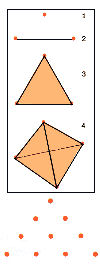 |
| To the Greeks, the number one corresponded to a point, and two to a line; three points defined a triangle, the simplest plane figure; four points defined a tetrahedron, the simplest space-occupying form. The Pythagorean tetractys (above) was composed of one, two, three and four dots arranged in rows |
Like all Greeks, they thought of number geometrically. One was
a point, two a line, three a triangle, the first plane figure, and
four a tetrahedron (which
resembles a pyramid, but has a triangular
base), the first solid figure. These four numbers between them thus describe
the whole of space. The Pythagoreans venerated them in a symmetrical pattern
called the tetractys, and believed it was 'eternal nature's fountain
spring'. Number pervaded the Pythagoreans' entire cosmology. Creation was
seen as the division of primordial unity into parts.
Each number had a certain significance attached to it; broadly, the Pythagoreans
believed that the world was composed of a series of ten pairs of opposite
corresponding to oddness or evenness in numbers
- limited/unlimited,
right/left,
male/female, and so on.
In Hebrew, as in Greek, numbers were represented by letters
of the alphabet, and this may well have stimulated gematria, the Jewish art
of turning names into numbers. This was done simply
by totalling the numbers that the letters stood for. The central idea of
gematria was that things referred to by words whose letters added up to the
same number were somehow the same; number expressed their true essence.
This technique was applied, for example, to the story told in Genesis 18:
Abraham was sitting at the door of his tent in the plains of Mamre 'and lo,
three men stood by him'. The Hebrew for 'and lo, three men' adds, by gematria,
to 701 - and so do the words 'these are Michael, Gabriel and Raphael'. The
obvious conclusion was that the three 'men' were actually archangels.
It was natural for early Christians to take up the numerological
ideas of the two dominant intellectual traditions - Greek and Jewish - that
surrounded them. The early symbol of the dove for Christ, for example, was
probably adopted because the Greek letters alpha and omega - 'I am Alpha
and Omega, the beginning and the ending, saith the Lord' (Revelation 1:8)
- add to 801, the number of peristera, the Greek for 'dove'.
For the Christians, as for the Pythagoreans, goodness and maleness
were associated with the odd numbers. One stands for perfection, unity, God.
Two, as the first number to break away from that perfection, represents the
Devil. And since odd numbers dominate in addition (odd + even = odd), and
addition represents sexual union, odd numbers must
represent the male sex.
| The Beast from the sea described in chapter 13 of the book of Revelation, as portrayed in a German altarpiece of about 1400. The meaning of the Beast's 7 heads, 10 horns and 10 crowns, and of its number, 666, has been the subject of much speculation by number mystics. They have variously interpreted the Beast as representing Rome, the emperor Nero, and even Napoleon Bonaparte | 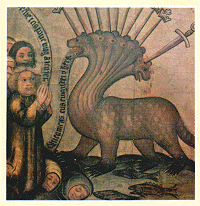 |
The Bible, early Christian theologians believed, provided
confirmation of the evil associated with two. For in the account of the Creation,
did not God neglect on the second day to find that his work was good? And
before the Flood, the unclean animals went into Noah's ark two by two, whereas
the clean animals went in by sevens. Modern numerologists are more generous
to the number two, preferring to emphasise its positive qualities, but it
nonetheless remains the least favoured of the numbers
(see page 1301).
Three is the first male number. One by itself although
perfect, is barren; two introduces a discord that can only be resolved
by adding the two numbers together to make three. It is this symbolism that
is behind the Christian doctrine of the Trinity; as the 19th-century French
magician Eliphas Levi put it: Were God only one, He would
never be creator or father. Were He two, there would be antagonism or
division in the infinite, which would mean the division also, or death, of
all possible things. He is therefore three for the creation by Himself and
in His image of the infinite multitude of beings and numbers.
 |
| In Hebrew, numbers are represented by
letters. To write 456 the letters for 400, 50 and 6 would be written together
|
The number of ill-luck
Four is the Pythagorean number of solid earth, being the number of points
required to define a tetrahedron. It may be solid and uninspiring, but as
Plutarch put it, writing around the turn of the first century AD, 'Those
who exalt Four teach us a lesson that is not without value, that by reason
of this number all solids came into being.' But four is also the number of
evil and ill-luck, being made up of two twos, in two different ways (4=2+2=2
x2).
Five, on the other hand, is the number of male sexuality: it
is made up of two and three: the first feminine number added to the first
masculine number. Thus, in love, woman is given to man - and
man 'naturally'
dominates.
Six is the first 'perfect' number
- it is the sum of its factors (numbers that divide it without remainder).
Thus 6 = 1 + 2 + 3. Perfect numbers were venerated for their tranquillity
and harmoniousness. In ancient times only the first four perfect numbers
were known: 6, 28, 496 and 8128. The next one -
33,550,336 - was apparently not discovered until
the mid 15th century.
Seven is a number rich in biblical associations. There are seven
deadly sins, seven Christian virtues, seven petitions in the Lord's prayer;
on the seventh day of the siege of Jericho, Joshua marched seven times round
the walls of the city and flattened them with a blast from seven trumpets;
and Pharaoh's dream which Joseph interpreted, involved seven fat and seven
lean cows, seven plump ears of corn and seven blighted ones. In folklore
too mystery attaches to the number seven, magical properties are
attributed to seventh sons and seventh sons of seventh sons. The power of
the number seven stretches far back in time: around 2500 BC the great Sumerian
king Lugulannemund built a temple in the city of Adab to the goddess Nintu,
with seven gates and seven doors, purified with the sacrifice of seven times
seven fatted oxen and sheep. One can only guess at the significance of this
frequent use of the number - but it seems that it is linked with
the phases of the
Moon, which take about 28 (=4 x 7) days to go through a complete cycle.
The ancients believed that the cycles of birth and death, growth and decay,
depend on the waxing and waning of the Moon.
|
|
| Above: the Devil tempts Jesus, in a 12th-century painting
from the ceiling of a Swiss church. The time that Jesus spent in the wilderness
being tempted by the Devil was 40 days and 40 nights - a period that occurs
often in the myth and folklore of all countries |
|
| Left: the Trinity, painted by El Greco in about
1600. God the Father cradles Jesus, his son, while
the Holy Spirit in the form of a dove, hovers above. The difficult notion
of the three-in-one God is not explicitly stated in the Bible, but was formulated
by theologians to reconcile various conceptions of God scattered through
the Old and New Testaments. To numerologists, God could not be single, since
he would then be uncreative; nor twofold, since this is the nature of antagonism
and conflict |
|
The symbolism of the numbers eight and nine is connected with
human procreation: a woman's body has eight orifices, the eighth being the
one through which new life enters the world. Eight is thus the number of
worldly success. Nine is the number of completeness because a human child
is conceived, formed and born in nine months. A few numbers greater than
nine were regarded as having a special significance. Twelve, for instance,
is a number of completeness: there are 12 months in the year, 12 signs of
the zodiac, 12 tribes of Israel and, of course, 12 disciples Thirteen is
a number of excess - it goes one beyond a number of completeness. The fact
that there were 13 people at the Last Supper strengthens the uneasiness many
people still feel about the number. This feeling is so strong that, for instance,
when Queen Elizabeth II visited West Germany in 1965, the number of the platform
at Duisburg station from which her train left was changed from 13 to 12a.
One more number with ancient sacred and mystical connections is 40. The rain
that caused the Flood in Genesis continued for 40 days and 40 nights; this
is also the time that Moses spent on Mount Sinai, speaking with God. The
children of Israel walked 40 years in the wilderness, and Jesus was tempted
by the Devil for 40 days and 40 nights. Forty has been sacred since ancient
Babylonian times, when it was known as kissatuin, 'the excellent quality'.
The 'Greek poet Hesiod, writing in the eighth century BC, explains that 40
days is the period for which the star cluster called the Pleiades
disappears. These stars are of widespread importance: ancient authors state
that autumn sowing should be performed when the Pleiades set at dawn, and
some peoples use them to mark the passage of a year. The 40-day disappearance
of the Pleiades may also have started the habit of measuring periods of time
of agricultural significance in 40-day periods - as in the belief that a
fine St Swithin's day (15 July) will be followed by 40 days of good weather,
while a rainy one presages 40 days of rain.
Armed with these interpretations of numbers, the Christian
theologian had at his fingertips a powerful tool for unravelling the hidden
meaning of any biblical text. The crowning glory of biblical number symbolism
is the book of Revelation. Written in 22 chapters - the 'master' number,
the number of things traditionally supposed to have been created by God,
the number of letters in the Hebrew alphabet - it is full of numerological
puzzles. The greatest and most famous of these is the
puzzle of the number of the Beast, 666:
And I stood upon the sand of the sea, and saw a beast rise up out of the
sea, having seven heads and ten horns, and upon his horns ten crowns, and
upon his heads the name of blasphemy. And I saw one of his heads as it were
wounded to death; and his deadly wound was healed: and all the world wondered
after the beast.... Let him that hath understanding count the number of the
beast: for it is the number of a man; and his number is six hundred threescore
and six.
 |
| 'The Great Beast' is the inscription in Greek on the medallion
worn by the magician Aleister Crowley in this self-portrait. Crowley adopted
the mysterious number ascribed to the Beast in the book of Revelation: 'six
hundred threescore and six' |
The identity of the Beast
There have been many conjectures as to the identity of the Beast. It is now
generally accepted that the Beast is meant to stand for the Roman empire,
and the seven heads for seven emperors. The head wounded to death and then
healed could represent Nero; he was murdered in AD 68, but there were persistent
rumours that he lived on. Nero, in Hebrew, adds up to 666 - but only if spelt
with an extra N. Otherwise it adds up to 616 -and some early manuscripts
do, indeed, give the number of the Beast as 616. The image of the Beast'
of chapter 15 may represent Caligula, who in AD 30 had set up a statue of
himself in the Holy of Holies in Jerusalem, and gave the order that the Jews
were to worship it (although he died before the command could be enforced).
Gaius Caligula Caesar in Hebrew adds to 616, as does Gaios Kaisar in Greek.
Numerologists, however, have not been content with these simple
explanations, and speculations as to the Beast's identity have ranged far
and wide. In the early 19th century there was an attempt to make Napoleon
into the Beast. Thomas Macaulay, the English statesman, refused to accept
this hypothesis; with typically mordant wit, he announced that the House
of Commons was obviously the Beast: it had 658 members, three clerks, a serjeant
and a deputy, a doorkeeper, a chaplain and a librarian -making 666 in all.
The magician Aleister
Crowley believed himself to be the Beast; he had, he claimed, discovered
his true identity while still a boy, with 'a passionately ecstatic sense
of identity'. He signed himself 'The Beast 666' - or sometimes To mega
therion, which means 'the great Beast' in Greek. Its number is 666.
Pyramids and Prophecies |
| One of the more eccentric manifestions
of mankind's fascination with number symbolism is
pyramidology. One pyramidologist in particular,
an American named Worth Smith, claimed that the Grand Gallery of the Great
Pyramid of Cheops enshrined a complete history of the Christian Church, with
particular emphasis on Britain's History. He believed the pyramid was built by ancestors of the British. He believed that the point at which the Grand Gallery begins represents Christ's birth on 6 October in the year 4 BC. Each inch (2.5 centimetres) represents a year. For the first 400 inches (10 metres) the stones are smooth; then they suddenly become scarred and broken. 'this, Smith claimed, represented the first 400 years of the Church's existence, a reasonably peaceful period that ended with the invasion by the Visigoths. The prophetic insight of the Egyptian builders or their lack of engineering skill - is demonstrated by another bad1y surfaced stretch: this, according to Smith, represents the rise of Islam from 622 (Mohammed's flight from Mecca) to an important defeat in Europe in 732. At the point supposedly corresponding to 1844 the gallery ends in the Great Step, which is 3 feet (1 metre) high. This should represent some kind of improvement in the fortunes of Christendom, but Smith is forced to admit that there was no great advance in 1844. He theorises rather lamely that 'almost the whole lot of the discoveries and inventions in common usage have come into existence since the year 1844.' According to Smith the scale now changes so that one inch represents a month. A new tunnel, the Low Passage, supposedly begins on 4 August 1914, the date of Britain's entry into the First World War, and ends on 9 November, date of the Kaiser's abdication. Smith expected the current year 1936 - to see the dethronement of Satan himself. |
On page 1370: the importance of number relationships
to artists and scientists

